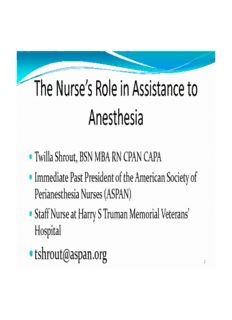
The Nurse's Role in Assistance to Anesthesia PDF
Preview The Nurse's Role in Assistance to Anesthesia
The Nurse’s Role in Assistance to Anesthesia (cid:1) Twilla Shrout, BSN MBA RN CPAN CAPA (cid:1) Immediate Past President of the American Society of Perianesthesia Nurses (ASPAN) (cid:1) Staff Nurse at Harry S Truman Memorial Veterans’ Hospital (cid:1) [email protected] 1 Objectives (cid:1) Identify methods to assist the anesthesia team (cid:1) Discuss methods to stay current in perianesthesia nursing 2 Preadmission (cid:1) (cid:1) -Psychosocial status -Relevant preoperative (cid:1) status -Substance/alcohol (cid:1) (cid:1) -Physical assessment -Anesthetic history (cid:1) (cid:1) -Cognitive ability -Discharge Planning (cid:1) (cid:1) -Patient safety needs -Procurement supplies / (cid:1) equipment -Pain assessment (cid:1) (cid:1) -Learning needs -Comfort assessment (cid:1) (cid:1) -Preop pt. teaching -Name preference (cid:1) (cid:1) -Plan of care -Cultural / language (cid:1) (cid:1) -Referrals -Advance directives Day of Surgery (cid:1) -Review / complete (cid:1) -Anesthetic history preoperative assessment (cid:1) -Verify pt. ID (cid:1) -Relevant preoperative (cid:1) -Verify prescribed status surgical prep (cid:1) -Normothermia (cid:1) -Responsible adult/ assist (cid:1) -Pain assessment home (cid:1) -Comfort assessment (cid:1) -Safe transport (cid:1) -Patient safety needs (cid:1) -Preprocedural teaching ASA Status ● ASA 1-normal, healthy ● ASA 2-mild, systemic disease (i.e. chronic bronchitis, moderate obesity, DM Type 2, mild HTN, old MI etc) ● ASA 3-severe systemic disease (CAD with angina) ASA Status ● ASA 4-severe systemic disease that is a constant threat to life (cardiac insufficiency, dysrhythmias, advanced pulmonary, renal, hepatic or endocrine insufficiency) ● ASA 5-not expected to survive without operation ● ASA 6-brain dead who’s organs are being used as donor ● “E” emergency patient with unknown history World Health Organization Guidelines for Safe Surgery 2009 (cid:1) Safe Surgery Saves Live (cid:1) The purpose is to improve the safety of surgical care around the world by defining a core set of safety standards that can be applied to all countries and settings. Why the Checklist is Important (cid:1) The team must work together (cid:1) All components of the checklist must be completed (cid:1) Prevents poor communication among the surgical team members (cid:1) Prevent surgical errors or deaths (cid:1) Prevents adverse legal issues Human Factors Principles (cid:1) Avoid reliance on memory (cid:1) Simplify (cid:1) Standardize (cid:1) Use protocols and checklists (cid:1) Improve information access (cid:1) Reduce handoffs (cid:1) Increase feedback Pre Procedure CHECK-IN Patient/patient representative In Holding Area actively confirms with RN (cid:1) Identify (cid:1) Beta blocker medication given (cid:1) Procedure and procedure site (SCIP) (cid:1) Consent(s) (cid:1) Venous thromboembolism (cid:1) Site Marked by person performing prophylaxis (SCIP) the procedure (cid:1) (cid:1) RN confirms presence of Normothermia measures (SCIP) (cid:1) H/P, Pre anesthesia assessment, diagnostic and radiological results, blood products and any special equipment/devices/implants
Description: